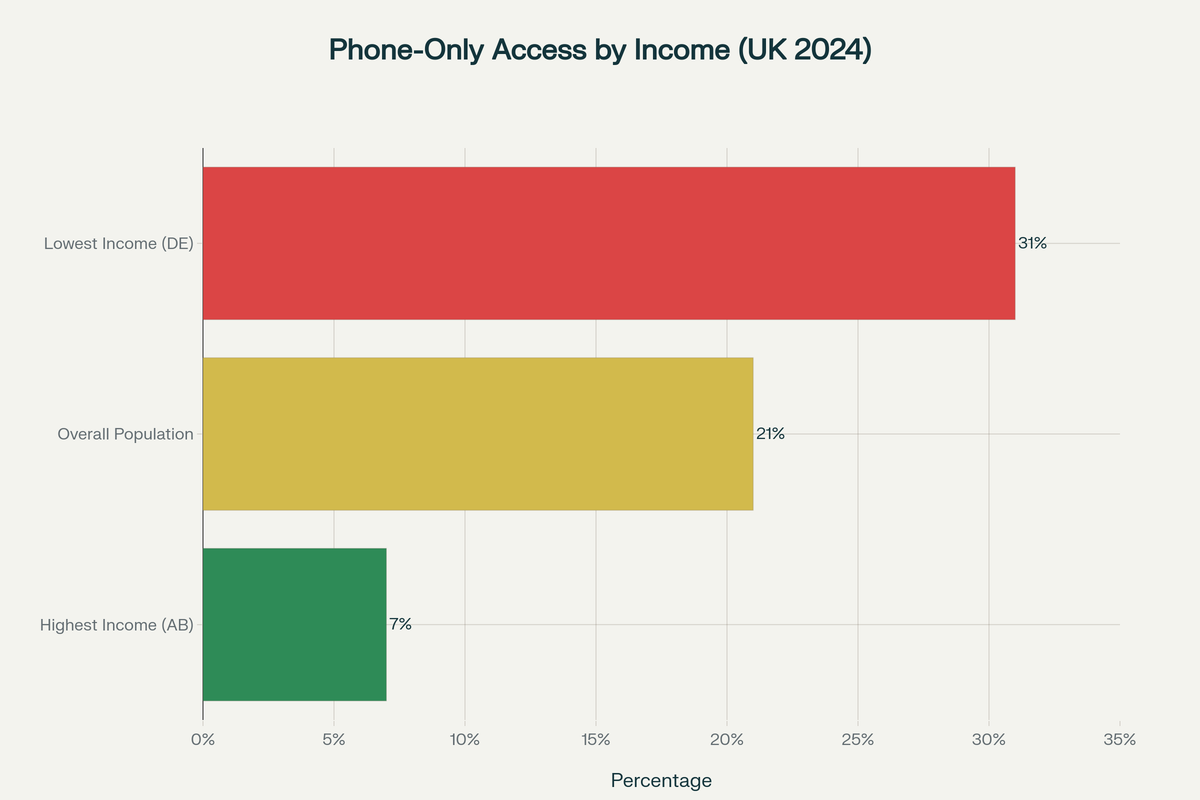- Product
Digital Equity and Mobile-First Assessment: Why RM Compare is Redesigning for Real Access

Assessment technology should work for every learner, not just those in affluent schools with modern devices and reliable broadband. Yet, as RM Compare moves toward a mobile-first user experience, new evidence reveals just how critical this shift is to educational equity. For millions of students in the UK and billions worldwide, smartphones are not merely one device choice, they are the only digital device available.
This month, RM Compare is publishing a comprehensive white paper examining digital equity in education across the UK and globally. The findings are striking, and they fundamentally shape how we should design assessment technology.
The Digital Divide: Closer Than You Think
In the UK, a nation with world-leading education infrastructure, the numbers may surprise you:
- 21% of UK adults access the internet exclusively via smartphone—and this rises to 31% among the lowest-income groups
- Among pupils eligible for Free School Meals (2.2 million students), many lack access to adequate devices for assessment
- Over 50% of students with only one device at home report that device is a smartphone, yet most assessment platforms were designed for desktops first

This chart demonstrates the stark digital equity divide in the UK, where individuals from lower socioeconomic groups are more than four times as likely to access the internet exclusively via smartphones compared to those in higher income brackets.
These UK figures pale beside the global reality. Around the world:
- In Sub-Saharan Africa, only 51% have smartphone access at all, and only 27% access mobile internet
- A smartphone costs the poorest 20% in Sub-Saharan Africa 87% of their monthly income, making device affordability, not design, the primary barrier
- Over 85% of primary schools in Sub-Saharan Africa lack internet connectivity, meaning mobile is not merely preferred, it is the only option
The essential insight: For disadvantaged learners everywhere, smartphones are not optional extras—they are the gateway to educational opportunity.
Why Android Matters More Than You Realise
If assessment platforms were designed by market share in affluent countries, Android and iOS would get equal weight. In reality, Android commands 70-72% of the global smartphone market, rising to 95% in India, 85% in Africa, and 84% in South America. Yet in UK and North American conversations, iOS often receives disproportionate attention.
For RM Compare's global ambitions, this matters enormously. Consider:
- India alone has 439 million smartphone users, with 95% on Android
- Africa has over 1 billion mobile phone users, with 85% on Android
- iOS, by contrast, penetrates deeply only in North America (58%) and parts of Europe (33-57%)
The implication is clear: designing excellent Android experiences is not secondary, it is essential for serving the global majority. Yet Android fragmentation adds complexity. While 79% of UK iOS users run the latest iOS 18, only 34% of Android users globally run the latest Android 15. Supporting older versions is not a nice-to-have; it is a prerequisite for reaching disadvantaged populations.

Mobile OS distribution varies dramatically across regions. While Android commands 71% globally and dominates in developing markets (95% in India, 85% in Africa), iOS leads in wealthy regions like North America (58%) and the UK (52%). For global educational equity, strong Android support is non-negotiable.
The OS Version Support Dilemma: NHS and TfL Show the Way
UK public sector organizations have grappled with this question directly. In February 2025, the NHS App updated its minimum requirements to iOS 15+ and Android 8+. This change affected approximately 12,000 single-device users who could no longer use the native app, but enabled modern security standards and native app features.
Transport for London uses a different approach. TfL Go requires iOS 16.4+ (affecting fewer than 3% of iOS users), while its legacy Pay to Drive app supports iOS 10+ (affecting almost nobody). This variation reflects differing functionality requirements.
For RM Compare, the lesson is clear: every OS version requirement is a trade-off between functionality and equity. Supporting Android 8+ reaches 86% of UK users but excludes older devices disproportionately held by low-income users. Supporting Android 9+ enables better offline features and security but excludes a few more. We always make these decisions transparently, with clear understanding of who is excluded.
Mobile-First Design Is Not Enough—But It's Essential
Smartphones themselves don't solve digital poverty. Affordability barriers, limited data plans, poor connectivity, and lack of relevant content remain formidable challenges in developing markets. Yet mobile-first design ensures that when learners do have access, the experience is optimised for the device they actually use, rather than forcing them to struggle with desktop-optimised interfaces on small screens.
Research on mobile learning confirms that:
- Progressive Web Apps enable offline access, critical in regions with intermittent connectivity
- Responsive design and accessibility compliance (WCAG 2.2 AA) benefit all users, especially those with disabilities
- Smaller data footprints matter where mobile data is expensive or limited
RM Compare's shift to mobile-first, paired with Progressive Web App architecture, represents the right direction. It is coupled with clear commitments to accessibility, offline functionality, and ongoing support for older devices that remain prevalent among disadvantaged users.
What This Means for Educators
If you lead an organisation serving disadvantaged students:
- YOU SHOULD EXPECT assessment platforms to work beautifully on smartphones, not as an afterthought
- YOU SHOULD DEMAND offline access in case of connectivity issues (increasingly common during school disruptions)
- YOU SHOULD REQUIRE accessibility compliance meeting accessibility standards
- YOU SHOULD ASK vendors about OS support strategy—transparency about version requirements is essential
The White Paper: Evidence for Action
RM Compare is publishing a comprehensive white paper examining these issues in depth, with data from the UK and global territories. It includes:
- Detailed evidence on smartphone dependence by socioeconomic group in the UK and worldwide
- Regional analysis of device access, OS fragmentation, and educational infrastructure across Africa, South Asia, Southeast Asia, Latin America, and more
- Practical recommendations for OS version support decisions balancing equity and functionality
- Case studies from NHS, TfL, UNESCO, and others navigating these trade-offs
The white paper is designed for educational leaders, technology partners, policymakers, and anyone committed to digital equity in assessment.
Digital Equity and Devices White Paper
Assessment technology should work for every learner.
A Commitment to Inclusion
RM Compare's move to mobile first design reflects a deeper commitment: that assessment technology should work for every learner, regardless of their postcode, family income, or access to modern devices. The evidence presented in this white paper demonstrates why this commitment is not charitable, it is essential.
Millions of UK students and billions worldwide depend on smartphones as their only gateway to digital learning. Designing assessment platforms that exclude them is not just ineffective, it perpetuates educational inequality. By embracing mobile-first architecture, supporting Android robustly, enabling offline access, and maintaining transparency about OS requirements, RM Compare can help ensure that Adaptive Comparative Judgement - a powerful and valid assessment tool - reaches the learners who need it most.
Key Findings at a Glance
Key Findings at a Glance
- 31% of UK's lowest-income group are smartphone-only internet users, compared to 7% of the highest-income group
- Android dominates globally at 70-72%, rising to 95% in India and 85% in Africa
- Only 40% of primary schools worldwide have internet connectivity, making mobile the only assessment option for billions
- Device affordability is the barrier: smartphones cost 87% of monthly income for the poorest in Sub-Saharan Africa
- UK public sector apps balance equity and functionality: NHS requires iOS 15+/Android 8+ (97%/86% coverage); TfL varies by use case
RM Compare is committed to designing assessment technology that works for every learner. For more information on our mobile-first strategy, accessibility commitments, and partnerships advancing digital equity, visit compare.rm.com or download the full white paper.
Where are we right now?
While the current RM Compare user interface is responsive, it has not been built 'mobile-first'. We are starting to address this now. We are making good progress and will be in a position to complete some user testing on some early iterations very soon - if you are interested get in touch.
Any changes we make will be small and targeted initially at specific parts of the system - do not expect a 'big-bang' change. We have written about how we build before and the reasons behind our approach.
You can keep up to date with all of our efforts by checking in on the Roadmap.
